Due to the large number of reservoirs, large lakes and other wetlands, Extremadura is one of the richest communities of birds associated with aquatic ecosystems. Below I present the most representative waterfowl of Extremadura (including waders).
Anatidae. Waterfowl of Extremadura
Black-necked grebe Podiceps nigricollis

Slightly larger than the Little Grebe, its plumage is more showy, especially during the mating season. Much less frequent than its relative, there are a few breeding pairs in the region, although it can be found all year round. For breeding, it usually prefers small lakes, but the rest of the year it looks for large reservoirs or makes small migrations to coastal areas. In winter, the reservoirs in the eastern area of Badajoz can be a good place to observe it: Orellana, Sierra Brava, La Serena… It feeds on aquatic invertebrates, but also on small fish and amphibians. It’s one of the smallest waterfowl in Extremadura.
Common loon Gavia immer
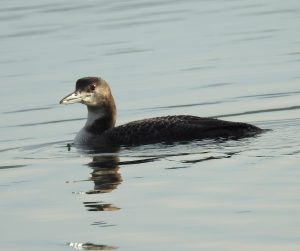
Although it is a rarity both in Extremadura and in the rest of inland waters, I recently had an encounter with this bird of the Gaviidae family so I have decided to include it. It is a medium/large sized, robust looking bird that is specialized in catching fish but also other small aquatic animals. We can occasionally observe it in winter, when its coloration is grayish, with lighter underparts. From far away it could look like a cormorant but if we can see it at a reasonable distance it is very easy to differentiate it. As we have already said, it is an eminently marine bird, therefore its sightings are very occasional.
Common pochard Aythya ferina

Diving duck with a certain resemblance to the red-crested pochard. Males differ in that they have light backs and black beaks. It feeds on invertebrates and likes clean waters with abundant vegetation. In Extremadura it breeds in Llanos de Cáceres, Vegas Altas of Guadiana and La Albuera, although during the winter we can see it in other areas of the community.
Common shelduck Tadorna tadorna

Intermediate in size between a duck and a goose, this beautiful bird is characterized by its colorful colors. It usually prefers coastal environments, but in inland areas such as Extremadura we can see it mainly in winter. At this time populations from northern Europe visit us, although it is rare as a breeder. Their sightings are sporadic and there are no populations that can be considered “stable”. However we can observe it in reservoirs and large lagoons, where it feeds mainly on aquatic invertebrates.
Gadwall Mareca strepera

The size of a Mallard, it is one of the most discreetly coloured ducks. It lives in open, calm and shallow water bodies where it feeds on aquatic vegetables. In the breeding season it requires the presence of emerged vegetation and islets for nesting. Present all year round in Extremadura, in winter its population increases with European specimens. As it has certain requirements in terms of habitat, its population suffers fluctuations and is currently not very abundant. It does not tolerate excessively the human presence.
Garganey Spatula querquedula
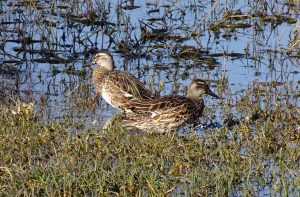
Small duck whose male is very characteristic for having a white stripe on its head. The female is brownish brown, with a gray bill. In Spain it hardly breeds, but it is locally abundant during migratory passages. Its population is really very scarce in Extremadura and we can observe it occasionally in both provinces, mainly in postnuptial migration. It occupies shallow wetlands with abundant vegetation.
Great crested grebe Podiceps cristatus
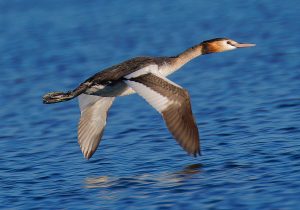
Neither the Great Crested Grebe nor the Little Grebe are in the family of the Anatidae, but I have decided to include them here because of similarities. It’s one of the waterfowl of Extremadura whose populations have grown the most in recent years. A diver, it feeds mainly on fish, although it may occasionally consume invertebrates or small amphibians. Its courtship is especially striking, when its plumage acquires very striking colours with a kind of crest and characteristic plumes. It is not particularly demanding in terms of water quality or marsh vegetation and is distributed throughout the region.
Egyptian goose Alopochen aegyptiaca

Slightly smaller than a common goose, this allochthonous goose from Africa has settled in Extremadura’s reservoirs in recent years, and its populations are growing exponentially. It is notable for its colourfulness and for its shrill shriek when threatened. There are currently stable populations in almost of the big lakes. They are currently displacing many other waterfowl of Extremadura, so they have recently listed as a game species.
Eurasian teal Anas crecca
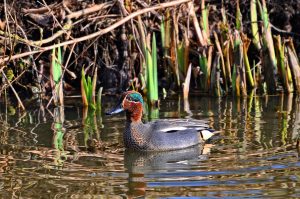
It is the smallest of the Extremaduran ducks and its plumage is really beautiful, especially in the males. Common in reservoirs, lagoons and irrigation ponds, it feeds on vegetation and aquatic invertebrates. Very abundant in winter, it migrates to northern Europe to breed. It can be found throughout the region and is not particularly threatened. However, it is not very tolerant of human presence, which added to the loss of habitat, means that its populations are not very numerous.
Eurasian wigeon Anas penelope

A wintering duck in the region, with beautiful plumage. It has a marked sexual dimorphism, like the majority of the ducks, the male being characterised by its chocolate head and grey body. It frequents reservoirs and lagoons, in which it feeds on leaves, roots, bulbs or rhizomes. Its population is relatively stable, although it is not abundant in the region. The reservoirs of Valuengo, Arroyo Conejos, Orellana, the Canchales and the lagoons of the Albuera are good points to observe it.
Ferruginous duck Aythia nyroca

Very scarce both in the Peninsula and in Extremadura, however we can occasionally observe it both in Cáceres and Badajoz. It needs well-preserved wetlands with plenty of floating vegetation to settle. Of medium size and brownish colors, as its name suggests, it is easy to differentiate from other pochards. Quite elusive, it is clearly endangered and breeding populations are on the verge of extinction in our country. Its diet is omnivorous, predominantly vegetables, although it does not disdain small vertebrates and aquatic invertebrates.
Greylag goose Anser anser

It is the largest waterfowl of Extremadura and of the Iberian Peninsula. It visits us in winter and the fertile upper plains of the Guadiana shelter his major concentrations. Together with the reservoir of Valdecañas are the best spots to observe it, with several thousand specimens visiting them annually. It likes to feed both in shallow wetlands and in cereal, rice and corn fields.
Little grebe Tachybaptus ruficollis

It is one of the smallest waterfowl of Extremadura, and has the ability to stay submerged for several minutes in the water. It feeds mainly on aquatic invertebrates, but also on small amphibians and fry in its dives. The little grebe breeds in lagoons or ponds with abundant floating vegetation, but in winter it is also very common in reservoirs. It has a great capacity to colonize new habitats and is currently present throughout the region.
Mallard Anas platyrhynchos

It is the most common waterfowl of Extremadura and also of Spain. Worldwide, it is capable of developing in practically all water masses, including urban ones. In addition to the important resident population, Extremadura receives in winter many specimens from European countries. It feeds on both aquatic plants and small vertebrates or invertebrates.
Northern pintail Anas acuta

It is the most slender duck and is characterized by its long tail. It feeds on aquatic vegetables and small invertebrates. Very abundant in Sierra Brava and Alcollarín reservoirs. We can also observe it in Orellana, Cornalvo, los Canchales and La Albuera. As in most ducks, there is a marked sexual dimorphism: females are browner and have a shorter tail.
Northern shoveler Spatula clypeata

Duck characterized by its very long and flattened beak, whose male has a very showy nuptial plumage. More wintering than breeding, it breeds nevertheless in some areas of the peninsula, and Extremadura is among them. It likes shallow wetlands rich in underwater vegetation. The best places to observe it are: the city of Badajoz, La Albuera, Cornalvo reservoir, Los Canchales, Sierra Brava, Cubilar and Orellana.
Ruddy shelduck Tadorna ferruginea

Rarer still than its congener the shelduck, there are sightings of isolated specimens in the region. Its population is in decline in Europe and can be considered exotic in Extremadura. We can see them mainly in reservoirs, both in Cáceres and Badajoz, without a stable population. It differs from the Tarro blanco by its much more uniform reddish color, although it also has black and white feathers on the wings. It is an omnivorous species, although it prefers plant-based foods such as stems and shoots.
Red-crested pochard Netta rufina

This beautiful diving duck has a pronounced sexual dimorphism between male and female. The male is especially beautiful with a chocolate head and a deep red beak. In Extremadura it breeds at the Orellana reservoir, the Portaje reservoir and the small Morantes reservoir. It is not a very common waterfowl of Extremadura, and is in a delicate state of conservation in the category of vulnerable.
Tufted duck Aythia fuligula

This diving duck is unmistakable because of its characteristic bow and has a marked sexual dimorphism. The males are black and white and the females are browner, with a shorter bow. More abundant in the province of Cáceres than in the province of Badajoz, it visits us mainly in winter, although there have been reports of breeding pairs. It likes reservoir waters with a certain depth, where it feeds on plant matter as well as small mollusks, crustaceans and insects.
Herons and storks. Waterfowl of Extremadura
Black Stork Ciconia nigra

One of the most iconic waterfowl of Extremadura, in danger of extinction due to the loss of its habitats, finds in this region its main breeding grounds. With customs totally different to the white stork, it does not tolerate human presence and needs tranquillity for its reproduction. Most of the navigation limitations of Extremadura’s reservoirs are made to protect this species, so we must be very careful to disturb it as little as possible when we sight it. We can observe it in Sierra de Gata, Gabriel y Galán, Alcántara lake, Monfragüe, Peña del Águila reservoir, Los Molinos reservoir in Las Villuercas, Sierra Brava and of course the Orellana reservoir.
Common Spatula Platalea leucorodia

Its characteristic wide beak at the end, its white colour and its large size make it unmistakable, even in the distance. It prefers shallow wetlands where it feeds on aquatic invertebrates as well as small fish or amphibians. Most of the population migrates to Africa in winter, although a growing percentage stays in the region all year round. We can see it in Gabriel y Galán lake, Almaraz, Los Canchales, La Albuera or Alange reservoir, among other places. It’s also one of the most iconic waterfowl of Extremadura.
Eurasian bittern Botaurus stellaris

This peculiar bird of the heron family has an extraordinary capacity to camouflage itself among the riverside vegetation. When it feels threatened, it stretches its neck, directing its beak upwards, and blends in perfectly with reeds and cattails. Its song is very powerful, it resembles the mooing of a bull, hence its name. It is in danger of extinction, although in slight recovery, and is one of the most difficult waterfowl to see. We can see it if we are very lucky in the Almaraz reservoir and in some sections of Guadiana River.
Glossy ibis Plegadis falcinellus

This species of ibis is becoming more and more frequent in the region. Thousands of individuals can already be observed in Guadiana River, mainly at the height of Badajoz, but also in the rest of the region. Sometimes also feeds in steppe areas on small vertebrates and invertebrates. Since 2012 it breeds in Extremadura, and we find its main population center in Badajoz dam, Montijo reservoir and Canchales reservoir.
Great egret Ardea alba

It’s the largest egret, almost as big as the purple heron. She is very spooky so we have to approach it carefully if we want to photograph it.Its populations are recovering, being more and more frequent as a wintering species, and some pairs have even reproduced in recent years in the region. Almaraz reservoir is once again an excellent place to see it, as well as Badajoz dam or Sierra Brava lake.
Greater flamingo Phoenicopterus roseus

A regular visitor to Mediterranean coastal areas but an occasional visitor to Extremadura, in recent years there have been several sightings at Canchales and Sierra Brava reservoirs. Unmistakable in appearance, it is one of the largest birds we can observe in the region and on the peninsula. It visits us in winter and its population trend in recent years is positive. It feeds on all types of invertebrates, from small crustaceans to larvae or protozoa, which it captures in shallow wetlands.
Grey heron Ardea cinerea

It is one of the most common waterfowl of Extremadura, rare is the body of water (pond, lagoon, river or reservoir) in which we can not observe it. It is a very skilled hunter and fisher, being able to catch practically all types of animals of an edible size. Slightly larger than the purple one and more greyish in colour, it is a typical species of Extremadura’s aquatic ecosystems. It feeds on small vertebrates, mainly fish, craws and amphibians.
Little bittern Ixobrychus minutus

One of the smallest herons, the size of a pigeon, is frequent on riverbanks, lagoons and reservoirs with abundant vegetation where it goes unnoticed. It is usually located when it flies from one bank to another, or by its song. More frequent in spring and summer, in winter most of the specimens migrate to Africa. It feeds on small aquatic vertebrates and invertebrates and can be found throughout the region provided there is a suitable habitat. Its population is not very numerous, although the difficulty in spotting it prevents us from having sufficient data.
Little egret Egretta garzetta

This small heron is characterized by its entire white plumage. Its black bill and legs make it easily distinguishable from the cattle egret in the distance. It is relatively abundant and lives in wetlands with shallow banks, where it feeds on small fish, invertebrates and amphibians. The little egret is present all year round in the region and usually feeds alone. It nests in large trees, forming mixed colonies with other herons.
Night heron Nycticorax nycticorax

This medium sized heron is characterized by breeding in numerous colonies along with other heron species. Very colourful with its yellow legs and red eyes, it surprises us (or surprises her) on many days when we take a walk near Guadiana river. Relatively abundant, we can find it in Almaraz, Guadiana river from Orellana to Alqueva and in the same Orellana lake. This heron usually begins to hunt when the sun goes down.
Purple heron Ardea purpurea

Slightly smaller than the grey heron, it is infinitely more rare and very elusive, so sighting it is a cause for joy. In Extremadura it is very localized, being zones of breeding and therefore good places for its sighting the own city of Merida, the dam of Badajoz, the river Zújar, the reservoir of Alqueva and Almaraz lake. Although it’s one of the waterfowl of Extremadura more difficult to see, we can see it relatively often along Guadiana River.
Squacco heron Ardeola ralloides
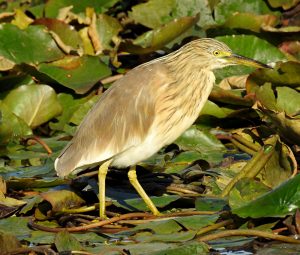
The same size as the frequent cattle egret, it differs from it mainly by its colors, having a blue beak and an ochre back. Like most of its relatives, it feeds on small fish, invertebrates, amphibians… It is a very rare waterfowl of Extremadura, with its main population centres in Orellana, Sierra Brava, Los Canchales, Azud de Badajoz and especially Almaraz. We can observe it from april to september mainly.
Western cattle egret Bubulcus ibis

This bird probably is not a typical waterfowl of Extremadura, probably I should have included in Mediterranean mountain bird section, but I will keep here because it will be easier to find. It has a white plumage, although It has also orange feathers on their head and neck in the nuptial season. Its presence is much less linked to the aquatic environment than that of other herons, although it usually breeds in colonies near bodies of water. It is very typical to see flocks of these birds among livestock, in pastures and grasslands, feeding on both invertebrates and small vertebrates. Its population is in clear expansion, being able to find it all over the region.
White Stork Ciconia ciconia
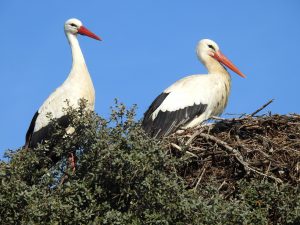
Unlike the black stork, the white stork is becoming more common, and a greater percentage of them stay in the region for the winter each year. It typically nests in the bell towers of villages, in the countryside it uses tall trees, electricity pylons, abandoned buildings… any platform high enough with difficult access to predators is valid for it. Although it typically moves through aquatic ecosystems, it is able to take advantage of grasslands and farming areas also to feed on small vertebrates.
Waders
Black-tailed godwit Limosa limosa

A wader of considerable size (it can have a wingspan of more than 70 cm), its population is in clear decline, both in Extremadura and throughout Europe. The rice fields of the Guadiana plains are an excellent area to observe it, since a significant number of individuals stop there during their prenuptial migration between January and March.
Black-winged stilt Himantopus himantopus

This miniature stork is a joy to watch in many wetlands of the community. In addition to rivers and reservoirs, it frequents the rice fields of the province of Badajoz, where it finds all kinds of invertebrates. They are quite frequent and very noisy so we will have no problem in locating it. The best areas to observe it are the reservoir of Arroyo Conejos, Alange, La Albuera, Orellana, Sierra Brava, Los Canchales and Azud de Badajoz.
Collared pratincole Glareola pratincola

The collared pratincole is a medium-sized wader that in flight reminds us of a large swallow. Cream-coloured, very pretty and striking, especially in spring, it emits a noisy song when moving in a group. They feed on insects in flight, and can be seen in the area of Llerena and Azuaga, Alange reservoir, la Albuera, Orellana, Sierra Brava and Los Canchales lagoons. Their reproduction is greatly affected by the level of the reservoirs because they like to breed on the islands.
Common greenshank Tringa nebularia

It is the largest of the greenshanks inhabiting the region, of good size and long legs. Its colouring is quite light and its beak is very slightly curved upwards. Wintering in Extremadura, it can be seen during the coldest months in the reservoirs of Cornalvo and Los Canchales, and occasionally in other shallow wetlands. It feeds on invertebrates and occasionally on small fry.
Common redshank Tringa totanus

Slightly smaller than a pigeon, and browner in colour than a redshank. It has red legs and is found in shallow waters of rice fields, reservoir tails and temporary lagoons. There it feeds on aquatic invertebrates and can capture small amphibians and fry. It has a breeding population in some parts of the peninsula, but in Extremadura it hardly breeds at all and is considered a wintering bird. It is not very abundant in the region.
Common ringed plover Charadrius hiaticula

It is the only plover that does not breed on the peninsula, wintering on the peninsula and in the region. It has a large head and a short bill with which it feeds on small invertebrates, both terrestrial and aquatic. In addition to its size, it is distinguished by its orange bill with a black tip. It is mainly coastal, but can be seen in Sierra Brava, Cornalvo and Los Canchales reservoirs.
Common sandpiper Actitis hypoleucos

One of the smallest waders, lighter in colour and with shorter legs than the large sandpiper, lives in shallow wetlands. It is present in the region in winter, migrating in the breeding season towards the north, although it can occasionally reproduce. The common sandpiper feeds on small invertebrates that it captures on the surface or in muddy banks. It likes the banks of streams, rivers and reservoirs as long as they are sandy but with gravel and pebbles. It is not currently threatened, although it is not particularly abundant.
Common snipe Gallinago gallinago

A small wader with incredible agility in flight, it comes to Extremadura only for the winter. Similar to a woodcock but with much more aquatic habits, it feeds on small invertebrates that it captures in shallow waters. It is also very common to see it in the rice fields of Las Vegas Altas. Relatively common in rivers, banks and wetlands, it is more abundant in the province of Badajoz. Its populations are in decline due to the loss of habitat in its breeding areas and because its a waterfowl of Extremadura that has hunting pressure.
Curlew sandpiper Calidris ferruginea

It stands out for its white obiscile and its reddish plumage during the nuptial season. It is not an abundant species on the Peninsula, where we can find passing or wintering specimens. More abundant in the province of Badajoz, it can be found in practically any wetland. It is often found in mixed groups together with sandpipers.
Dunlin Calidris alpina

A small, slender-legged, long-billed wader that usually runs along the silty banks of lakes and reservoirs. Present in Extremadura during the winter months, it feeds on small invertebrates. Also quite coastal in its habits, it is nevertheless at home in marshy areas, wetlands and other inland aquatic ecosystems. It is more abundant in the province of Badajoz and is currently not endangered.
Eurasian curlew Numenius arquata

It is the largest of the waders in Extremadura, unmistakable because of its long curved beak. Its plumage is light brown with dark spots and its whitish belly. It feeds on slimy shores and rice fields of aquatic invertebrates. There is no established population, sightings are occasional and always in winter. As its populations are so fluctuating, it is difficult to determine a more suitable area for sightings, however Sierra Brava and Cubilar reservoirs and Las Vegas Altas are interesting spots.
European golden plover Pluvialis apricaria
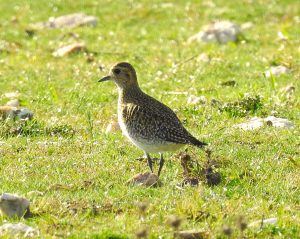
The size of a dove, this wader visits the region in large flocks in the winter season. Speckled yellowish-brown with a short beak, it feeds on worms and other invertebrates on plains and waterlogged meadows. It is often seen in mixed flocks with lapwings. In spring it returns to more northern countries to breed. Los Llanos de Cáceres, Las Vegas Altas and La Serena host important populations of several thousand individuals each.
Green sandpiper Tringa ochropus

Small wader characterised by its strong contrast between its white belly and dark brown back. Its bill is slender and long, adapted for catching invertebrates in shallow water. Its legs are slender, greyish-green and it has a characteristic wagging tail and body swaying movement. Wintering in the region, it is distributed in all types of inland waters with a positive population trend. It can be confused with the common sandpiper, but it is well differentiated because the light spot on the belly is smaller and does not go up to the beginning of the wings.
Grey plover Pluvialis squatarola

This species of plover is much less abundant than the golden plover, but it also visits us during the winter. Either on migratory passages or because it hibernates in the Iberian Peninsula, we can observe it between October and March approximately. Like the dorado, its breeding plumage is much more striking, although we cannot normally see it with its plumage, as it breeds in northern Europe and Asia. More common in coastal areas, it can be seen in different wetlands in Extremadura.
Jack snipe Lymnocryptes minimus

The smallest of the snipe, although its populations are rather scarce, it visits Extremadura every winter. It is most likely to be seen in the province of Badajoz, although during its migrations it can be seen throughout the region. It feeds on small invertebrates that it captures on the edges of wetlands or sufficiently damp ground. When we surprise it and it takes flight, it emits a very characteristic song.
Kentish plover Charadrius alexandrinus

Another wader with very coastal habits, but which can also be seen in the region. It is easily identified from other plovers by its red beret. Rare in the region, it rarely breeds in Extremadura, although in winter it is easier to see specimens from European countries. It feeds on small invertebrates, both insects and worms, and is classified as vulnerable.
Little ringed plover Charadrius dubius

Small wader characterized by its black collar and mask and a bright yellow eye ring. It usually walks along the silty banks of ponds and streams where it feeds on small invertebrates. It nests on rocky shores and islands where there is gravel and sand and during the cold season it migrates to Africa. This plover is not particularly threatened, although habitat loss and nest predation affect its populations negatively.
Little stint Calidris minuta

It is the smallest wader in the region, and is characterised by its black legs and bill. The underparts are white and the back is mottled brown. It feeds mainly on aquatic invertebrates and although it is an eminently coastal bird, it can be found in the region during the winter. The reservoirs of Sierra Brava, Cornalvo and Los Canchales are frequently visited by these sandpipers, whose population has been fairly stable in recent years.
Marsh sandpiper Tringa stagnatilis
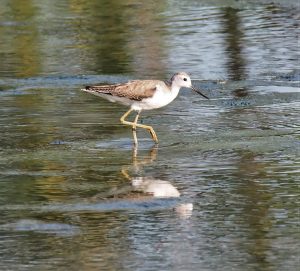
An occasional wader in the region, it is characterized by its greenish legs. It feeds on small invertebrates in shallow waters. Its wintering area is mainly in the African continent, and during this migration we can observe some specimens in Extremadura. The best places to observe them are the Montijo reservoir and Vegas Altas del Guadiana.
Pied avocet Recurvirrostra avosetta

Similar in size to the black-winged stilt, although much scarcer, it is one of the most striking waders because of its contrasting black and white plumage. It occasionally visits the region in winter, having been sighted mainly at Sierra Brava and Orellana reservoirs. In winter, some specimens come from more northerly areas, making them easier to spot.
Red knot Calidris canutus

Rare in our territory, we can observe it occasionally during the winter or during the passage season. It has a predilection for large beaches and sandy or muddy marshes, with little vegetation. It feeds mainly on invertebrates found along the shores of lagoons and reservoirs. During the breeding season it has bright colors with reddish tones, but when it visits our territory it has a fairly uniform gray color, darker on the back. It also has a pale eyebrow and striations on the sides of the chest.
Ruff Calidris pugnax

Relatively large wader, the size of a partridge that frequents natural wetlands and shallow reservoir banks. It is characterised by a very striking nuptial cortege in which the males display feathered plumes and dance. With its long, fine and robust bill, it feeds on aquatic invertebrates during winter. It breeds in Arctic and sub-Arctic areas and its population is quite threatened in the Iberian Peninsula. Very scarce in Extremadura, we can locate it during the migratory passage in the lagoons of the Albuera.
Sanderling Calidris alba

It breeds at really high latitudes, being one of the waders whose breeding area is furthest north. It spends the winter in mid-latitudes, especially in western European countries such as Spain, France, the United Kingdom and Ireland. A part of the population reaches Africa, which is why in the Iberian Peninsula and in Extremadura we can find wintering or passage populations. White and grey in winter, it is not rare (although not frequent) in Extremadura, although the bulk of the population tends to live in coastal areas.
Spotted redshank Tringa erythropus

Infrequent in the region, although it is usually seen in the migratory passages in autumn and spring. Like the common redshank, the legs are red or orange and it has a darker color than the common redshank, almost black in nuptial plumage. It is mainly coastal, although it can inhabit inland wetlands and rice fields. In the region we can observe it in the Albuera, the Canchales and the Vegas Altas, feeding on invertebrates associated with the aquatic environment.
Temminck’s stint Calidris temminckii

A rare species both on the Iberian Peninsula and in Extremadura, which can occasionally be seen during its migration. It breeds in northern Europe and Asia, moving to Africa to spend the winter. It likes all types of humid areas where it can be seen alone or in small flocks. Small size, discreet plumage and also discreet habits, as it is not usually seen together with other waders.
Wood sandpiper Tringa glareola

It is a very stylized wader with longer legs than other sandpipers. It breeds in northern Europe and Asia and in winter migrates to Africa, so in the peninsula it is usually found passing through. Sporadically it can be wintering and we can locate it in shallow wetlands, where it feeds on invertebrates, mainly insects. The destruction of its wintering habitat has caused it to decline in recent decades.
Passerines associated with the aquatic environment.
Bearded reedling Panurus biarmicus

It is not a very abundant bird in the region but there are sedentary populations that inhabit the region throughout the year. It is usually found in wetlands, with large areas of reeds, bulrushes, cattails…. The bearded reedling usually feeds on their edges and is a rather shy bird. It is not easy to see and the male is characterized by two black spots that resemble a mustache, hence its name. There are populations in the Almaraz reservoir, the banks of the Guadiana and in the small reservoirs near Arroyo de la Luz.
Common grasshoper warbler Locustella naevia
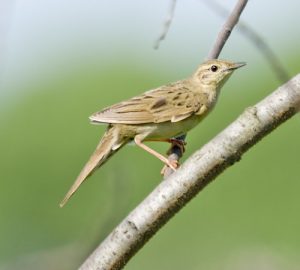
Slightly smaller than a sparrow, its mottled brown plumage blends in perfectly with the marshy vegetation it inhabits. It feeds on small insects and spiders, and is present in Extremadura only during its migratory passages. The Arrocampo reservoir is the best place to observe it, both in spring and autumn. In Spain it only breeds on the Cantabrian coast and likes to frequent wetlands and riverbanks with dense marsh vegetation.
Common kingfisher Alcedo atthis

This small but beautiful bird shows incredible skills for fishing small fish and tadpoles. I have decided to include it among the waterfowl for the same reason as the dipper. It swoops for its prey and is able to dive with great skill. It inhabits all kinds of wetlands in the region, always with a minimum quality of water and in winter the population increases due to the migration of individuals from northern countries.
Common reed bunting Emberiza shoeniclus

Although there are small breeding nuclei in the Iberian Peninsula, the specimens we can see in Extremadura are always wintering, coming from central and northern Europe. Brownish on the back and whitish on the belly, the male has a striking black head during the nuptial period. They usually move in flocks in areas of reeds, cattails and other marsh vegetation and are very clearly identified by their song, similar to a whistle. They usually seek the edges of crops where they feed mainly on seeds.
Common waxbill Strilda astrild

Originally from Africa, the common waxbill or common strilda is an invasive species that has been permanently inhabiting the peninsula for several years now. Very small size, usually lives in flocks of dozens of specimens in areas of marsh vegetation. It feeds on small seeds and occasionally on insects. It can be found in more and more marshy areas, mainly in the province of Badajoz.
Eurasian penduline tit Remiz pendulinus
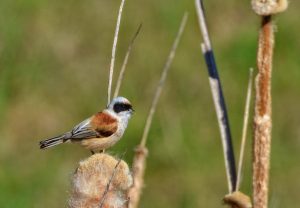
The size of a goldfinch, it is easily identified by its black mask, grey head, reddish-brown back and pink belly. It lives in banks with abundant marshy vegetation, reeds, swords, bulrushes… The Almaraz reservoir is one of the best places to observe it, as well as Las Vegas Altas del Guadiana. It feeds on insects and other invertebrates and is present all year round in the region. In winter many specimens arrive from northern countries and their populations are slightly increasing.
Eurasian reed warbler Acrocephalus scirpaceus

Small bird with very discreet colours that inhabits the banks of rivers and streams with abundant marsh vegetation. It stands out for its powerful song and feeds mainly on invertebrates. It is most abundant in the province of Badajoz and the best places to observe it are Guadiana dam and river Caya in Badajoz, Vegas Altas and Almaraz. At the end of summer it migrates to Africa and is not currently threatened.
Great reed warbler Acrocephalus arundinaceus

It is the largest of the peninsula’s warblers, slightly larger than a sparrow and characterised by its peculiar song. With a greyish-brown or greenish back and a lighter belly, its habitat is very similar to that of the common reed warbler. Like the reed warbler, it migrates to Africa in summer and is not endangered, although it is slightly less abundant than its companion. It feeds mainly on invertebrates, although outside the breeding season it may eat small fruits and seeds.
Grey wagtail Motacilla cinerea

Very similar in appearance to the western yellow wagtail, it differs from this one in that in addition to the beret, it also has a bluish-grey back, and it also has a black throat. It is closely linked to continuous and clean water currents, which is why it is more common in the north of Cáceres. It is present all year round in the breeding areas, and in the winter the region also receives specimens from more northern countries. The grey wagtail also feeds on small invertebrates and its state of conservation is good.
Red avadavat Amandava amandava

This passerine is one of those present in this block that are not native to this country. Its populations probably arose from releases or escapes, as they are birds widely used as pets. It has adapted very well to the plains near the aquatic environment, taking refuge in reeds, cattails and shrubs and other riparian vegetation. They present a clear sexual dimorphism, being the males of very showy red colors and the females gray with reddish obispillo. They tend to adapt very well to anthropic environments, they are hardly afraid of humans.
Savi’s warbler Locustella luscinioides

Similar to the common grasshoper warbler, it differs from the latter in that it has more reddish colors, without stripes and a more rounded tail. Quite shy, it is only seen when it is singing. In Extremadura there are some resident populations and lives in areas of reeds and cattails. Almaraz or the banks of the Guadiana are 2 points where we could observe it. It also feeds on small invertebrates, always near wetlands.
Sedge warbler Acrocephalus schoenobaenus

This small bird mimics incredibly well and is quite difficult to spot. Present in the region during migratory passages, there is no stable population in Extremadura throughout the year. Present in humid areas with a lot of marsh vegetation, it is characterized by a dark crown and a pale eyebrow. Common in central and northern Europe, it migrates to Africa in winter and it is during this migration when we can observe it making a stopover in our country. Rare in Extremadura, we can observe it both in the wetlands of Cáceres and Badajoz.
White-throated dipper Cinclus cinclus

About the size of a blackbird but a little more chubby and with a white chest. Perhaps it is not the most appropriate to include it among waterfowl of Extremadura, but I have decided to do so, as I have divided it by habitat. It lives mainly in the well-preserved rivers north of Cáceres, with clean waters, where it captures underwater invertebrates. We can also observe it in the area of Guadalupe and near Gabriel y Galán reservoir.
Western yellow wagtail Motacilla flava

Small bird typical of wetlands, irrigated meadows and riverbanks. It is also used to move among the cattle and stands out because of its grey beret, its olive yellow back and its bright yellow belly. It feeds on small insects and invertebrates and is frequently observed on its migratory passages, although some couples manage to reproduce. Not very common in the region, Los Llanos de Cáceres is one of the areas where we can most easily observe it. In winter it migrates to Africa.
White wagtail Motacilla alba

The size of a sparrow, it is characterized by its long tail and its white, black and gray tones. It frequents riverbanks, the banks of reservoirs and irrigated crops, feeding on small invertebrates. Present all year round in Extremadura, it is more frequent in winter. During the winter it tends to concentrate in large roosts in urban parks. It is very adaptable to different environments and its population is not threatened.
Yellow-crowned bishop Euplectes afer

Invasive in nature, its populations have increased greatly in recent years throughout the Guadiana basin. It adapts very well to areas with riverside vegetation such as reeds, rushes, bulrushes, but also to rice fields. This colourful bird has marked sexual dimorphism during the breeding season, when the males are black and bright yellow. It feeds mainly on seeds, but in the breeding season invertebrates become an important part of its diet.
Zebra finch Taeniopygia guttata
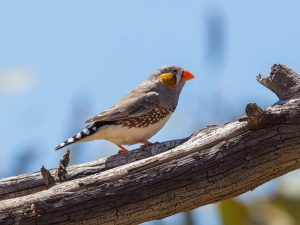
The finch, also known as the mandarin finch or zebra finch, is a species introduced in the region, originally from Oceania. Its use as a pet has meant that it is now present in many countries around the world, with ever-increasing populations. It is highly adaptable to different environments, although it is usually associated to marshy areas. It groups together in flocks of several dozen specimens and feeds mainly on seeds.
Zitting cisticola Cisticola juncidis

It is one of the smallest birds on the peninsula, brown in colour with dark spots on the back and a whitish belly. It inhabits areas of marshy vegetation, crops and riverbanks. Present all year round in Extremadura, it feeds on small insects and other invertebrates. It can be identified by its undulating flight, which is usually accompanied by a characteristic song. It is distributed throughout the region, although La Serena, Orellana, Los Canchales and Los Llanos de Cáceres are the best places to observe it.
Ralids and other waterfowl of Extremadura
Baillon’s crake Porzana pusilla

It is the smallest crake and its sightings are very rare in the region. Most of them take place in the province of Badajoz. It can mainly be seen during migratory passes, as part of the European population migrates to Africa or to our country to spend the winter. This bird has a predilection for damp areas with shallow water and low but dense vegetation, where it can take refuge. It feeds mainly on aquatic invertebrates, complementing its diet with plants: stems, algae…
Black-headed gull Chroicocephalus ridibundus

A small gull, it is characterized by its dark chocolate head in its summer plumage. We can observe it in big reservoirs, rivers with slow currents, crops and rice fields. It is very abundant waterfowl of extremadura, especially in winter, staying a few specimens in summer to reproduce. It usually moves in numerous and very noisy flocks and feeds on small animals, both vertebrates and invertebrates. The black-headed gull is distributed throughout the region.
Black tern Chlidonias niger

A very rare species both in the Iberian Peninsula and in Extremadura, where it can be seen as a passage bird but not as a breeder. Small in size, like the whiskered tern, it is characterized by its dark color bordering on black during the breeding season, turning to grayer tones in summer. Normally we can observe it both in migratory passage and in winter in different reservoirs of the region, although sometimes we can also observe non-breeding specimens in summer. It feeds mainly on invertebrates and small fish.
Common gull Larus canus

Of medium size, it is a regular wintering bird on the peninsula, mainly on the coasts. A percentage of individuals go inland, mainly to large reservoirs, and it is in these that it can be seen in Extremadura. It is not particularly abundant and is intermediate in size between the smaller black-headed and mediterranean and other larger birds such as the lesser black-backed or yellow-legged. In addition to its size, it is easily identified by its white “mirrors” on the tips of its outer primaries. It feeds on small vertebrates and invertebrates associated with the aquatic environment.
Common moorhen Gallinula chloropus

The size of a partridge, this dark blue, almost black, pale is easily identified by its red beak with a yellow tip. It frequents all types of wetlands as long as there is little current and abundant marsh vegetation. Present throughout the year in the region, it also frequents the rice fields of Las Vegas Altas. With a great capacity to adapt, it’s also a very common waterfowl of Extremadura and feeds on both plant material and invertebrates associated with the aquatic environment.
Common tern Sterna hirundo

It is the most common of the terns in the Iberian Peninsula, however in Extremadura it is not very common and can be observed mainly during migratory passages. Its characteristic red bill and black beret make it easily identifiable. Its song is also very characteristic and at the end of summer it is usually grouped in large flocks. In Extremadura it can be seen mainly in large rivers and reservoirs, feeding on small fish and invertebrates.
Eurasian coot Fulica atra

Matte black, with a white beak and forehead, it is one of the most common waterfowl of Extremadura’s wetlands. Frequent in reservoirs, lagoons and wetlands in which it makes floating nests with the vegetation present there. Present all year round in Extremadura, it feeds on aquatic invertebrates and plants. It is not a particularly demanding species in terms of choice of habitat and its populations are widely distributed.
Great cormorant Phalacrocorax carbo

It is one of the most common waterfowl of Extremadura but also in the world. It is adapted to both marine and terrestrial ecosystems and in Extremadura its populations have grown exponentially. Large and black, it feeds mainly on fish, but also on other aquatic vertebrates. It has a predilection for large reservoirs in which it finds large numbers of small fish, although it can also be seen in smaller bodies of water.
Gull-billed tern Gelochelidon nilotica

The size of a pigeon but with thin and long wings, it is characterized by its black head, beak and legs. It frequents aquatic ecosystems such as reservoirs in which it breeds on islands devoid of vegetation, but we can also see it in meadows and crops. For example Orellana, Sierra Brava and Los Canchales reservoirs are good spots to see it. A summer bird in Extremadura, it migrates to Africa to spend the winter. It feeds on small vertebrates and some invertebrates, not necessarily associated with the aquatic environment.
Lesser black-backed gull Larus fuscus

A large gull with dark grey wings and a yellow beak, with a red spot on the underside. Frequent in reservoirs, dumps, crop fields… it has a great capacity to adapt. This waterfowl is very numerous in winter, but does not breed in the region. It feeds on all kinds of small vertebrates and invertebrates, as well as waste in rubbish dumps. It is distributed throughout the region and its population is on the rise thanks to its adaptability. One of the most common gulls and waterfowl of Extremadura.
Little crake Porzana parva
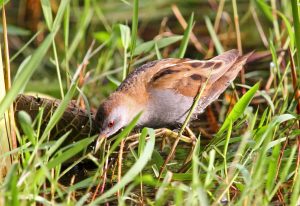
Very rare both on the Peninsula and in the region, it can be seen during the summer season, as it hibernates in Africa. Its shyness and rarity make it very difficult to observe. In Extremadura it can be seen mainly in some reed beds along the banks of the Guadiana. It has a predilection for areas of stagnant water and abundant vegetation: reeds, rushes, bulrushes, cattails… Similar to baillon’s crake (much more abundant), it differs mainly in that it has a red spot at the base of its beak and an olive-brown back (Baillon’s crake has a reddish-brown back). It feeds on invertebrates, almost always associated with the aquatic environment.
Little tern Sternula albifrons

It is the smallest of the terns, characterized by its long wings and forked tail that give it extreme agility. It is very curious to see the way it feeds, swooping from a considerable height to capture small fish. This tern breeds on the ground in small colonies, especially in Alange and Canchales lakes. Present in most of the reservoirs in the province of Badajoz, in winter it migrates to Africa.
Mediterranean gull Larus melanocephalus

Much less common than the Black-headed Gull, it is often found in mixed flocks with them, with which it is easily confused. It can be seen in practically all the reservoirs and wetlands of the region. The mediterranean has a more intense red bill and the primary feathers of the wings are black in the black-headed, while white in the mediterranean. Both have black or very dark heads in summer plumage, but the mediterranean is usually slightly larger. They tend to gather in groups and feed on invertebrates and small fish.
Spotted crake Porzana porzana

There is no stable resident population in Extremadura, although it can be observed with a certain regularity in the migratory passages. An important part of the European population migrates to Africa in winter, spending some time in the Peninsula and the region. Slightly larger than the other two crakes present in the community, it is also distinguished by its white patches on its breast. Also linked to the aquatic environment, it does not depend so much on “stable” wetlands and can adapt to any temporary waterlogged area. It feeds on both plants and small invertebrates.
Yellow-legged gull Larus michahellis

It is one of the most common gulls on the coasts of the Iberian Peninsula, although not so common inland. It is a large gull and in Extremadura it can be seen throughout the main rivers and lakes of Tajo and Guadiana basins. This gull feeds on all kinds of small animals, and is also very common in the vicinity of rubbish dumps. It can be seen throughout the year in the region, being more abundant in winter. It differs from the Lesser Black-backed Gull in its larger size and its back, which is lighter in colour in the Yellow-legged Gull.
Water rail Rallus aquaticus

Another one of the pale ones present in the region, the size of a common moorhen, but with a longer red beak and the most vivid colours. It has a brown back with black spots and a metallic blue chest and belly. Frequent in wetlands, rice fields, canals and ditches, provided there is abundant marsh vegetation. It is present throughout the year and feeds on both small vertebrates and invertebrates. More common in the province of Badajoz, it is not particularly threatened, although it is not abundant either due to its specific habitat requirements.
Western swamphen Porphyrio porphyrio

This large bird of the ralid family was on danger of extinction due to loss of habitat and high hunting pressure. However, the efforts made for its protection and its great capacity of recovery have contributed to the fact that today it is a settled species, even abundant in some wetlands of the community. The best spots for its sighting are Almaraz reservoir, the city of Badajoz itself, Los Canchales reservoir and Guadiana river between Merida and Badajoz. It’s one of the most beautiful waterfowl of Extremadura.
Whiskered tern Chlidonias hybrida

Slightly smaller than a turtledove, but with longer and thinner wings, it is easily identified by its black hood with red beak and legs. It feeds on insects and other aquatic invertebrates, and usually hunts in small groups. They build floating nests with branches in wetlands and dammed waters, and in late summer they migrate to Africa. We can observe it in Alange, Sierra Brava, Los Canchales reservoirs and Albuera lagoons.
Thanks to Manuel Martín, Alvaro de las Heras Olivecobirding, Mariano Cordero and Isaac Fernández Galisteo for the pictures of these waterfowl of Extremadura.





